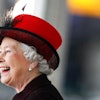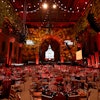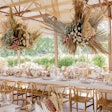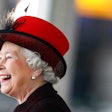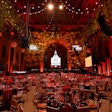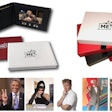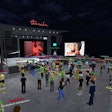
A decade ago, the phrase special events might have conjured flowers, table linens, or a talking head at a lectern. But far from being frivolous one-offs—if indeed they ever were—events and the industry responsible for executing them have evolved such that much of the discussion begins with business strategy, not decor, and extends far beyond the boundaries of a single evening. In 2011, event marketing is regarded as a sophisticated communication medium. (And the event industry seemed to lose the “special” somewhere along the way, as well.)
“I haven’t had a conversation with a client about flowers in eons. It’s just a given that the hydrangeas look nice,” says Fergus Rooney, owner and C.E.O. of Chicago-based AgencyEA, whose clients include Oprah Winfrey’s Harpo Productions, the Boeing Company, and the Obama administration. “We’ve evolved massively in the last decade.” The company launched in 1999 as Event Architects, doing small events for just two clients; now it has a staff of 30 and recently changed its name to reflect its work as a full-service experiential marketing agency. The company now consults on projects that extend far beyond the scope of the flowers-catering-venue model of old.
“There are a lot more players in the space and so many different ways that extensions and integrated programs are being built around live events, with a lot more marketing dollars being allocated,” says Elizabeth Shaffer, co-president of Gen Art, the organization that matches emerging creative talent with corporate sponsors, and recently relaunched after folding, following a failed corporate partnership last year. “Experiential marketing is a real industry now and needs to be included as part of the overall marketing and advertising canon.”
The trend toward making live events a more essential part of a brand’s marketing mix has grown over the past decade. A study sponsored by George P. Johnson Company and Meeting Professionals International in 2005 found that 96 percent of marketing executives included events in their marketing mix and 93 percent considered the importance of event marketing to be “constant or increasing.”
Along with respect for the profession has come an increased public awareness, partially because of TV shows with event planning characters, including Sex and the City and various reality shows. And with an increased interest has come a proliferation of educational programs to prepare students for the industry: On its Web site, the International Special Event Society now lists more than 300 universities and colleges around the world offering courses in events, meetings, hospitality, or tourism fields.
Bacardi senior brand manager Billy Melnyk estimates the rum brand now allocates 30 percent more of its total marketing budget for events than it did five years ago, and 50 percent more than 10 years ago—and that’s for a brand he says was always “on the forefront of experiential marketing” as a social-minded spirits purveyor. Bacardi hosts 10 to 15 large events and 50 to 60 smaller local events annually, also about a 30 percent increase over five years ago.
“Experiential marketing is an essential part of what we do,” says Melnyk, who is based in Miami.
Of course, more money spent on events means more scrutiny, too. Events—and their producers—must deliver results.
“Each year it gets harder to impress people. The audience is much more knowledgeable, and you really want to stand out and keep them wanting more,” says Elle’s New York-based executive director of special events and partnerships, Caitlin Weiskopf, who joined the team six years ago in a marketing role, before the magazine even had a designated event position. Realizing the value of events, and beginning to implement a signature event series, the magazine created the job and Weiskopf was well positioned to move into it. “It’s as much a blessing as it is a curse in the sense that everyone knows the value of events,” she says. “You have to overdeliver.”
Clients and higher-ups now expect a consistent flow of new ideas. “Ten years ago, it was very traditional,” says Rooney from AgencyEA. “People would say [in protest], ‘We’ve never done that before.’ Now they want to do exactly what they’ve never done before. That’s why content and creative become king.” He says corporate marketers expect well-executed branding, graphics, and video editing from vendors.
Ray Thompson, who founded Images by Lighting in Los Angeles in 1981, says, “Once you start driving a Mercedes, it’s hard to drive a Toyota. Clients are educated and notice the attention to detail.”
Hosts know they need to stand out in what can be a very full calendar. “The market is so saturated with events that a brand must be very specific in their end goals for both themselves and their partners, or you’ll get lost in the mix,” says Variety event marketing director Kate Mazzuca. That said, she adds, “Our senior management is very open to innovative event ideas, so [getting] the green light is fairly simple when the event interacts and supports the other areas of our business. People must now work smarter, both fiscally and creatively. Our industry is host to a dozen events on any given day or night, so you need to have a succinct strategy and end goal in sight to make it a success.”
Business goals are increasingly driving the decisions behind events. “Parties [once] were just parties,” says New York-based Dalzell Productions president Frank Riley. “Now they are experiential marketing occurrences with a purpose: sell and sample product, build a demographic, bring the online offline, bring a brand to a local market. Clients and audiences take events more seriously, so keeping them fun and memorable while reaching financial or marketing goals remains one of our major interests. Events are now part of the fabric of the marketing world, not just special occurrences.”
To that end, in the 2011 Experiential Marketing Forum’s Global Research study conducted with partner IMI International, and with input from 558 respondents around the world, experiential marketing was regarded on both the client and agency side as the highest in perceived effectiveness for getting out a brand message—vastly more effective than any other category, including outdoor advertising or print, radio, or TV ads. According to the report, both agencies and clients agree that experiential marketing and digital and social media are the top opportunities of the next few years, and describe their consumer as savvy and increasingly hard to please.
Indeed, just as business executives have become savvy about event marketing, so have attendees. Guests—especially the likes of celebrities, so-called “influencers,” and others in target-demographic categories—have passed through lots of parties. They know about food and wine, they travel, they keep up on the latest bands and venues. And they require innovative experiences to win their engagement.
In the modern event-marketing climate, it’s not enough, however, to grab people’s attention: Event professionals must be able to demonstrate those results with data as a significant part of justifying their budgets. Thus there’s an increased focus on tracking the success of events, and new tools have helped facilitate the evolution toward careful measurement.
“Every point of communication—e-blast, newsletter, tweet—is measurable and trackable, so the metrics of any campaign can become a comparable for future campaigns and considered against competitors, though metrics are often closely held or positively biased when reported,” says Dalzell’s Riley. “To that end, few firms are willing to give or market solely for their brand or logo exploitation. They expect measurable returns.” That means events must have clear goals and results.
Elle’s Weiskopf explains that the standard of success has changed with the new tools available for quantifying results. “When we first started, it was, ‘How many good people did we get? How many celebrities?’ Now our metrics of success include obviously the event itself—was it beautiful? But also it’s the reach. More and more, we’re going to see content generation is going to be something that’s going to be a big measure of success for us.”
To measure its events’ successes, Gen Art looks at the broad swath of resources available now: audience demographics and qualifications for buying, brand message and familiarity, sales purchase intent and value, cost per lead, media exposure, and the quantity and quality of social media impressions.
Co-president Shaffer says, “The more hard data you are able to provide that demonstrate an event’s direct and measurable value, the more likely you are to win business. Several years ago, this data was all based on estimates. Now with the new, affordable electronic tracking tools, we are able to weigh and analyze variable data points to give detailed information on direct value delivered for marketing spend.”
AgencyEA’s Rooney agrees that the determination of an event’s success—once a more straightforward assessment—is wrapped up in the availability of new measurement tools. “What’s a win? Originally, it was based on things like attendance, and now the goals are quite nebulous. Now it’s specific tools for each program, whatever each project needs.” These new, specific measurement tools have facilitated the evolution of the industry.
Part of achieving results depends on the shift of events from passive experiences a decade ago—show up, get drinks and hors d’oeuvres from a server—to active experiences. “It’s touch-screen, product sampling,” says Rooney. Says Variety’s Mazzuca, “Now more than ever, we really look for robust guest interaction and engagement with our activations in addition to quantifiable press mentions to gauge the success of an event.”
As events move from passive to active, they have also moved well beyond the start and end hours listed on an invitation: A live event is now a jumping-off point for a long-living program. The new model of events has more experiences for guests, and a longer tail of impact.
“It’s not just one night, like it was 10 years ago,” says Elle’s Weiskopf. “It’s networking, content generation, social media; it’s a 360-degree platform. We’ll promote an event for a month with viral campaigns and guerrilla tools. Now we can expand the experience to a wider audience, which at the end of the day is what everybody wants. The live event is an anchor for a much bigger marketing program.”
Changed, too, is the technology available, in terms of an event’s production as well as its execution. “I’m incredibly happy that we no longer have to use clipboards and we can use iPads,” Weiskopf says. “The tools have evolved tenfold from an execution and from an aesthetic perspective. Everything has been elevated.”
Images by Lighting’s Thompson adds, “Technology has become more affordable, and [top effects] have moved from the [big concert] stage into the [smaller] event arena.”
He also notes that the size of the industry as a whole has grown exponentially since he’s been in the business, citing just one major competitor when he entered the field 30 years ago, 10 or so a decade ago, and now more than 20 today. But the wealth of choices can help the industry thrive, rather than strangling it. “If [a cheaper vendor] is satisfactory, then next year [the client] may do another event, and maybe they’ll step it up. There’s a demand [for both of us]. We’re all busy.”
Supporting Thompson’s theory of the newly crowded marketplace is membership in the International Special Events Society, which now has 5,620 members, up from 2,963 in 2001—almost double the size of a decade ago.
Dalzell’s Riley says the crowded field is healthy for creativity. “Competition is growing, so trends are shorter-lived and expectations to stretch a budget creatively continue to be raised.”

